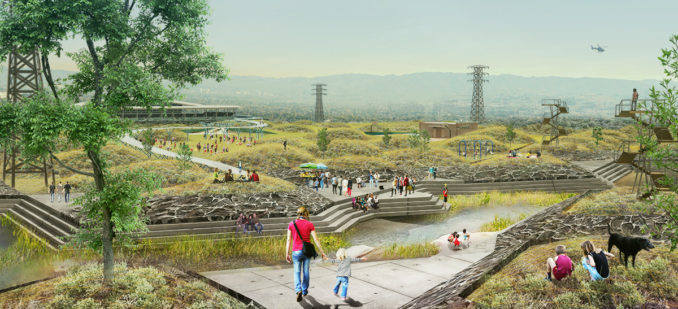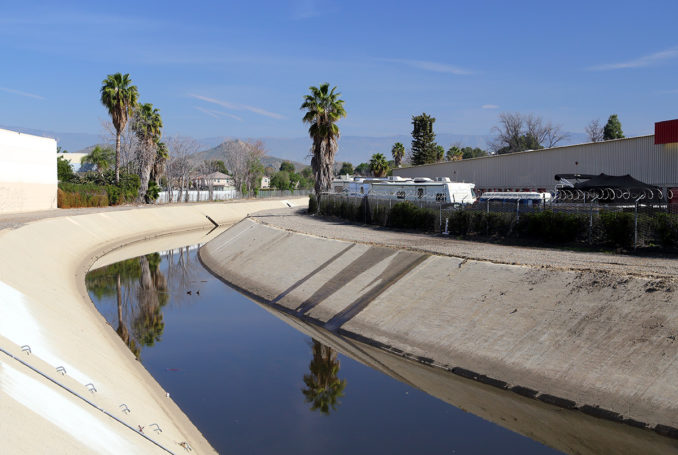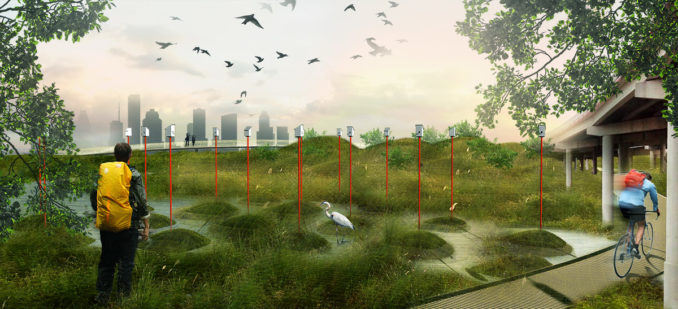
Flooding, on the rise due to climate change, can devastate urban areas and result in drawn-out, costly repairs. Cities are in dire need of new strategies to manage the influx of stormwater. An interdisciplinary team of engineers and urban planners at MIT has now developed a solution: multifunctional urban stormwater wetlands and ponds that seamlessly integrate the control and cleaning of stormwater with ecological and recreational benefits.
Stormwater flooding in cities is exacerbated by urban infrastructure, as many of the natural ecosystems that would absorb rainfall have been replaced with pavement, which greatly limits an area’s infiltration capacity. This keeps stormwater on the surface, where it picks up all kinds of pollutants — trash, heavy metals, industrial chemicals — that are eventually carried into nearby bodies of water, often including the local water supply.

Many cities do not have adequate systems in place to handle stormwater runoff, the largest single cause of stream impairment in urban areas. Stormwater treatment plants are large investments that need to be integrated into existing drainage and water treatment systems. Without spaces or processes that can sequester and purify contaminated water before it reenters circulation or the natural environment, urban centers lose fresh water that could be available for drinking and groundwater recharge, among other ecosystem needs.

Natural stormwater management systems — engineered green spaces — are becoming more popular options for cities, in part due to their affordability. The MIT team’s wetlands have been designed to be much more effective than existing designs, such as simple basins and serpentines, at controlling water circulation and purifying stormwater, while also delivering ecosystem and recreational benefits.
The MIT team has released the details of their study in a freely available report, “Design Guidelines for Urban Stormwater Wetlands,” in the hope that cities will adopt this approach. The report is based on two years of research funded by a seed grant from MIT’s Abdul Latif Jameel World Water and Food Security Lab (J-WAFS) and further supported by the MIT Norman B. Leventhal Center for Advanced Urbanism (LCAU) in MIT’s School of Architecture and Planning. These guidelines are based on physical experiments undertaken in the MIT Nepf Environmental Fluid Mechanics Lab and recently published in the journal Ecological Engineering.
“The goal of our study is to help cities mitigate their own problems in the face of rapidly changing climates, large storms, and a lack of economically feasible solutions,” says co-author Alan M. Berger, the Norman B. and Muriel Leventhal Professor of Advanced Urbanism and LCAU co-director. Berger and his co-authors welcome interested city representatives to reach out to them to discuss how to implement their designs. In May, the group conducted an outreach campaign to ensure that these open-sourced designs reach urban stakeholders such as government officials and regional planners across the U.S.
The guidelines combine engineering, urban planning, and landscape architecture expertise to design a versatile green space. On top of managing stormwater, the wetland or pond creates greenery for the city, recreational space for the community, and valuable wildlife habitats.
The designs, which feature a series of clustered islands, are modular and scalable, so they can be tailored to fit the needs and resources of varying urban settings. The work was developed with two specific case studies, Houston and Los Angeles, to help ensure the adaptability of the guidelines to different localities.
“We picked L.A. and Houston because they are both large cities in warm climates, rapidly growing, mostly suburban, with good prospects for green space,” says lead researcher and lead author Celina Balderas Guzmán ’07, MCP ’13, SM ’13. “Moreover, one is very dry and one is very wet. We wanted to show our design’s adaptability to different conditions.” Balderas Guzmán, then an LCAU member and now at the University of California at Berkeley, is an alum of MIT’s School of Architecture and Planning, where she developed a master’s thesis on stormwater wetlands that eventually led to this collaborative, interdisciplinary project.
The guidelines have yet to be used in practice. However the team is currently in contact with city leaders in several locations about the prospect of building a pilot wetland systems. Unaffiliated members of the research community speak positively about the merit of the guidelines.
“As far as I know, there is nothing available to the practitioner community that translates research findings from engineers and landscape architects into reality so cleanly,” says David L. Sedlak, professor of environmental engineering at UC Berkeley and co-director of the Berkeley Water Center.
To develop the guidelines, researchers in the Environmental Fluid Mechanics Lab led by Heidi Nepf, the MIT Donald and Martha Harleman Professor of Civil and Environmental Engineering, tested more than 30 different wetland system designs. They monitored water circulation through sculpted models to determine which topography was most effective in slowing down the stormwater and evenly distributing its flow, in order to best enable the natural processes that cleanse the water of pollutants. This comprehensive testing strategy led to designs based on clusters of streamlined islands placed close together near the wetland inlets.
Controlling the water’s movement so it lingers in the wetland is crucial to give the ecosystem time to improve water quality. Wetlands purify water through a combination of biological and chemical processes, including giving contaminants time to settle out of the water. Wetland vegetation is another good filter, as plant surfaces and the biofilms they support are very effective at capturing pollutants and excess nutrients.
Determining the most effective design for stormwater treatment was a key aspect of the project, but the team emphasizes that the value of their wetland system is more than its water management functionality. Collaboration between engineers and urban planners led to a design that maximized efficiency without sacrificing aesthetic, ecological, or recreational quality.
“Stormwater management guidelines are typically written by engineers and they are very prescriptive. They are not traditionally designed to promote ecology or facilitate recreation,” Balderas Guzmán says.
The team was able to create a multifaceted wetland system designs thanks to its unique interdisciplinary makeup. Nepf, co-author of the study, says the engineers contributed hydraulic function innovations while the landscape architects envisioned how to make the wetland a valued part of the fabric of the city.
Sparking interdisciplinary collaborations is a goal of J-WAFS seed grants, and Nepf credits J-WAFS with helping the engineers and urban planners to work together, bridging their different design processes and “different languages.”
“J-WAFS provided a place where we could learn how to talk to each other,” Nepf says.
Because of this unique collaboration, the guidelines offer a rich variety of benefits. They include recreational trails, which bridge the island clusters and connect city streets to inviting green space. The largest islands can hold event spaces for public programming, while floodplains beside the wetland can be used as sports fields, picnic areas, or playgrounds. The islands provide multiple ecological habitat zones, from dry upland to shallow and then deeper water. This habitat could be especially valuable to wetland species as natural wetlands disappear.
The multiuse designs have a political advantage as well. They can help cities win public approval to implement stormwater wetlands, which have often proved to be challenging projects to get local residents to support. Communities unaware of the extent to which stormwater pollutes their water supply may not support using a space that could be a park or a playground for such a project. The addition of recreational features makes artificial wetlands an easier sell.
“I hope these guidelines open people’s eyes to how they can multipurpose land in urban areas,” Nepf says. “I hope we make them think, ‘Okay, I need something to deal with stormwater runoff, so how do I make something that might also benefit the environment and the livability of the city.’”
Image Credits – as captioned
Text Credit – Greta Friar | Abdul Latif Jameel World Water and Food Security Lab



